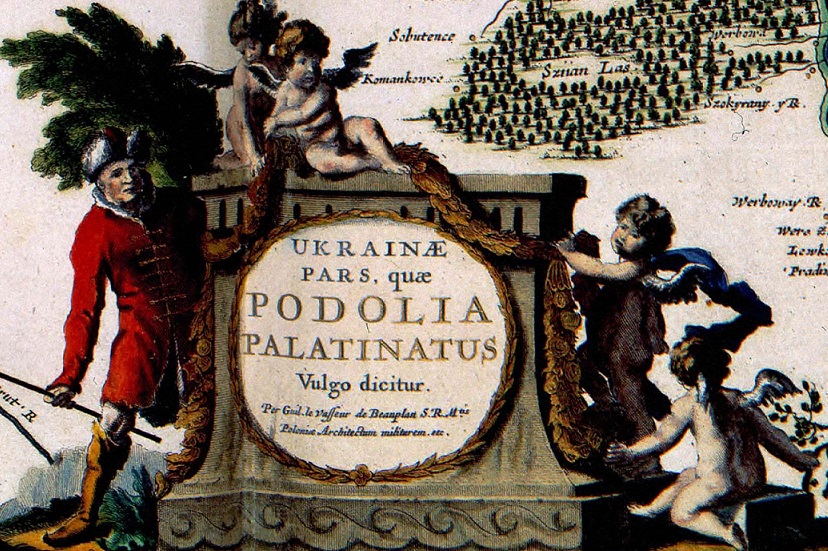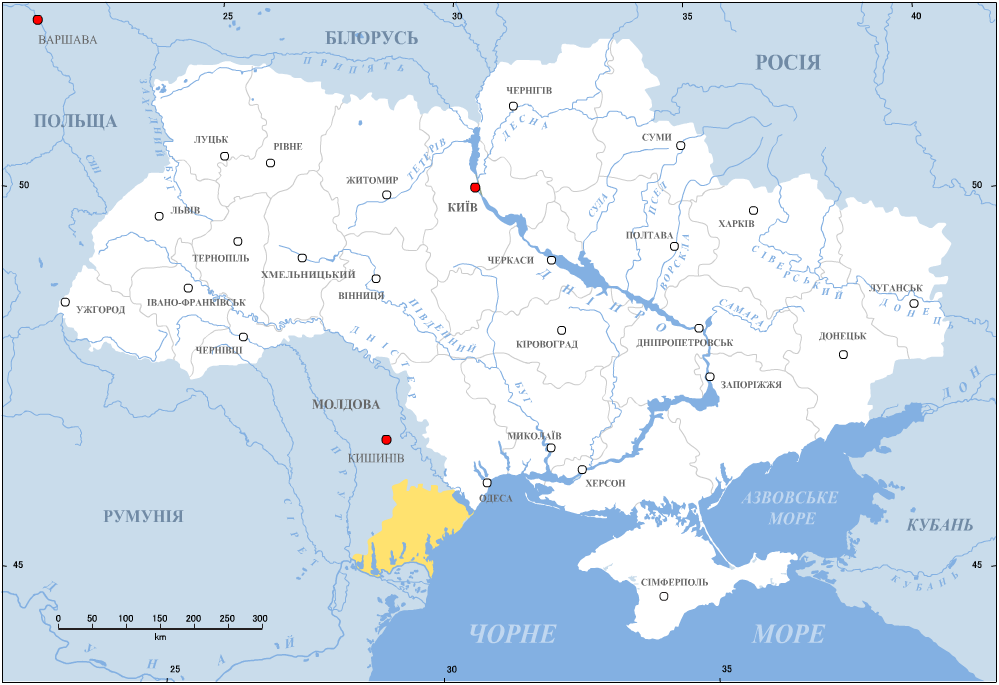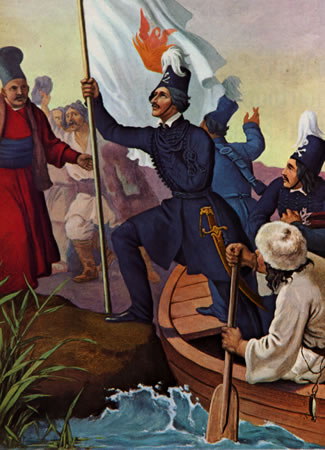|
Demetrius, Prince Of The Tatars
Demetrius, Prince of the Tatars ( la, Demetrius princeps Tartarorum) was a Mongol or Tatar ruler in the second half of the . In primary sources Demetrius was mentioned in medieval chronicles and in a Hungarian royal charter of 1368. According to the ''Lithuanian-Ruthenian Chronicle'', preserved in the ''Codex Suprasliensis'' and other codices, Algirdas, Grand Duke of Lithuania, invaded Podolia in 1363 and 1364 and defeated three Tatar chieftainsKutlug Bey, Hacı Bey and Demetriusin the Battle of Blue Waters in 1362 or 1363. Algirdas's invasion was the first military campaign that a European power launched in the territory of the Golden Horde. According ''Latopis Nikonowski'' the battle was in 1363, according to ''Latopis Hustyński'' in 1362.Księga ku czci Oskara Haleckiego, wydana w XXV-lecie jego pracy naukowej, 1935, p. 125. "Lord Demetrius, Prince of the Tatars" ''(dominus Demetrius princeps Tartarorum)'' was mentioned in a royal charter, issued 22 June 1368 by Louis I of ... [...More Info...] [...Related Items...] OR: [Wikipedia] [Google] [Baidu] |
Codex Suprasliensis
The Codex Suprasliensis is a 10th-century Cyrillic literary monument, the largest extant Old Church Slavonic canon manuscript and the oldest Slavic literary work in Poland. As of September 20, 2007, it is on UNESCO's Memory of the World list. The codex, written at the end or even in the middle of the 10th century, contains a menaion for the month of March, intersecting with the movable cycle of Easter. It also contains 24 lives of saints, 23 homilies and one prayer, most of which were written by or are attributed to John Chrysostom. The 284-folio (or 285-folio, according to some sources) codex was "discovered" in 1823 by Canon Michał Bobrowski in the Uniate Basilian monastery in Supraśl. In 1838, Bobrowski sent the last part of the manuscript in two pieces to Slovene philologist Jernej Kopitar so that he could transcribe it. After Kopitar returned it, Bobrowski sent him the first part (118 folios), however for unknown reason it was never returned to Bobrowski and was found in 1 ... [...More Info...] [...Related Items...] OR: [Wikipedia] [Google] [Baidu] |
Algirdas
Algirdas ( be, Альгерд, Alhierd, uk, Ольгерд, Ольґерд, Olherd, Olgerd, pl, Olgierd; – May 1377) was the Grand Duke of Lithuania. He ruled the Lithuanians and Ruthenians from 1345 to 1377. With the help of his brother Kęstutis (who defended the western border of the Duchy) he created an empire stretching from the present Baltic states to the Black Sea and to within of Moscow. Background Algirdas was one of the seven sons of Grand Duke Gediminas. Before his death in 1341, Gediminas divided his domain, leaving his youngest son Jaunutis in possession of the capital, Vilnius. With the aid of his brother, Kęstutis, Algirdas drove out the incompetent Jaunutis and declared himself Grand Duke in 1345. He devoted the next thirty-two years to the development and expansion of the Grand Duchy of Lithuania. After becoming the ruler of Lithuania, Algirdas was titled the King of Lithuania ( la, rex Letwinorum) in the Livonian Chronicles instead of the Ruthe ... [...More Info...] [...Related Items...] OR: [Wikipedia] [Google] [Baidu] |
Grand Duke Of Lithuania
The monarchy of Lithuania concerned the monarchical head of state of Lithuania, which was established as an absolute and hereditary monarchy. Throughout Lithuania's history there were three ducal dynasties that managed to stay in power—House of Mindaugas, House of Gediminas, and House of Jagiellon. Despite this, the one and only King of Lithuania who has ever been crowned was King Mindaugas I, although there were two more instances of royal nobles who were not officially crowned due to unfortunate political circumstances, but ''de jure'' received recognition abroad as kings of Lithuania from the pope or the Holy Roman emperor—Vytautas the Great by Sigismund of LuxembourgNadveckė, Ineta (6 July 2019Trys Lietuvos karaliai: vienas tikras, vienas nelabai ir vienas beveik'' LRT''. and Mindaugas II by Pope Benedict XV, respectively. Others were seen as kings of Lithuania even though they had only considered it and never took further action to claim the throne, as in the case o ... [...More Info...] [...Related Items...] OR: [Wikipedia] [Google] [Baidu] |
Podolia
Podolia or Podilia ( uk, Поділля, Podillia, ; russian: Подолье, Podolye; ro, Podolia; pl, Podole; german: Podolien; be, Падолле, Padollie; lt, Podolė), is a historic region in Eastern Europe, located in the west-central and south-western parts of Ukraine and in northeastern Moldova (i.e. northern Transnistria). The name derives from Old Slavic ''po'', meaning "by/next to/along" and ''dol'', "valley" (see dale). Geography The area is part of the vast East European Plain, confined by the Dniester River and the Carpathian arc in the southwest. It comprises an area of about , extending for from northwest to southeast on the left bank of the Dniester. In the same direction run two ranges of relatively low hills separated by the Southern Bug, ramifications of the Avratynsk heights. The Podolian Upland, an elongated, up to high plateau stretches from the Western and Southern Bug rivers to the Dniester, and includes hill countries and mountainous regions ... [...More Info...] [...Related Items...] OR: [Wikipedia] [Google] [Baidu] |
Battle Of Blue Waters
The Battle of Blue Waters ( lt, Mūšis prie Mėlynųjų Vandenų, be, Бітва на Сініх Водах, uk, Битва на Синіх Водах) was a battle fought at some time in autumn 1362 or 1363 on the banks of the Syniukha river, left tributary of the Southern Bug, between the armies of the Grand Duchy of Lithuania and the Golden Horde. The Lithuanians won a decisive victory and finalized their conquest of the Principality of Kiev. Background After the death of its ruler Berdi Beg Khan in 1359 the Golden Horde experienced a series of succession disputes and wars that lasted two decades (1359–81). The Horde began fracturing into separate districts (''ulus''). Taking advantage of internal disorder within the Horde, Grand Duke Algirdas of Lithuania organized a campaign into Tatar lands. He aimed to secure and expand southern territories of the Grand Duchy of Lithuania, particularly the Principality of Kiev. Kiev had already come under semi-Lithuanian control after ... [...More Info...] [...Related Items...] OR: [Wikipedia] [Google] [Baidu] |
Golden Horde
The Golden Horde, self-designated as Ulug Ulus, 'Great State' in Turkic, was originally a Mongols, Mongol and later Turkicized khanate established in the 13th century and originating as the northwestern sector of the Mongol Empire. With the fragmentation of the Mongol Empire after 1259 it became a functionally separate khanate. It is also known as the Kipchak Khanate or as the Ulus of Jochi, and replaced the earlier less organized Cuman–Kipchak confederation. After the death of Batu Khan (the founder of the Golden Horde) in 1255, his dynasty flourished for a full century, until 1359, though the intrigues of Nogai Khan, Nogai instigated a partial civil war in the late 1290s. The Horde's military power peaked during the reign of Uzbeg Khan (1312–1341), who adopted Islam. The territory of the Golden Horde at its peak extended from Siberia and Central Asia to parts of Eastern Europe from the Ural Mountains, Urals to the Danube in the west, and from the Black Sea to the Caspian ... [...More Info...] [...Related Items...] OR: [Wikipedia] [Google] [Baidu] |
Louis I Of Hungary
Louis I, also Louis the Great ( hu, Nagy Lajos; hr, Ludovik Veliki; sk, Ľudovít Veľký) or Louis the Hungarian ( pl, Ludwik Węgierski; 5 March 132610 September 1382), was King of Hungary and Croatia from 1342 and King of Poland from 1370. He was the first child of Charles I of Hungary and his wife, Elizabeth of Poland, to survive infancy. A 1338 treaty between his father and Casimir III of Poland, Louis's maternal uncle, confirmed Louis's right to inherit the Kingdom of Poland if his uncle died without a son. In exchange, Louis was obliged to assist his uncle to reoccupy the lands that Poland had lost in previous decades. He bore the title of Duke of Transylvania between 1339 and 1342 but did not administer the province. Louis was of age when he succeeded his father in 1342, but his deeply religious mother exerted a powerful influence on him. He inherited a centralized kingdom and a rich treasury from his father. During the first years of his reign, Louis launched a cru ... [...More Info...] [...Related Items...] OR: [Wikipedia] [Google] [Baidu] |
Kingdom Of Hungary
The Kingdom of Hungary was a monarchy in Central Europe that existed for nearly a millennium, from the Middle Ages into the 20th century. The Principality of Hungary emerged as a Christian kingdom upon the coronation of the first king Stephen I at Esztergom around the year 1000;Kristó Gyula – Barta János – Gergely Jenő: Magyarország története előidőktől 2000-ig (History of Hungary from the prehistory to 2000), Pannonica Kiadó, Budapest, 2002, , p. 687, pp. 37, pp. 113 ("Magyarország a 12. század második felére jelentős európai tényezővé, középhatalommá vált."/"By the 12th century Hungary became an important European factor, became a middle power.", "A Nyugat részévé vált Magyarország.../Hungary became part of the West"), pp. 616–644 his family (the Árpád dynasty) led the monarchy for 300 years. By the 12th century, the kingdom became a European middle power within the Western world. Due to the Ottoman occupation of the central and south ... [...More Info...] [...Related Items...] OR: [Wikipedia] [Google] [Baidu] |
Brașov
Brașov (, , ; german: Kronstadt; hu, Brassó; la, Corona; Transylvanian Saxon: ''Kruhnen'') is a city in Transylvania, Romania and the administrative centre of Brașov County. According to the latest Romanian census (2011), Brașov has a population of 253,200 making it the 7th most populous city in Romania. The metropolitan area is home to 382,896 residents. Brașov is located in the central part of the country, about north of Bucharest and from the Black Sea. It is surrounded by the Southern Carpathians and is part of the historical region of Transylvania. Historically, the city was the center of the Burzenland, once dominated by the Transylvanian Saxons, and a significant commercial hub on the trade roads between Austria (then Archduchy of Austria, within the Habsburg monarchy, and subsequently Austrian Empire) and Turkey (then Ottoman Empire). It is also where the national anthem of Romania was first sung. Names Brassovia, Brassó, Brașov, etc. According to Dragoș Mo ... [...More Info...] [...Related Items...] OR: [Wikipedia] [Google] [Baidu] |
Budjak
Budjak or Budzhak (Bulgarian and Ukrainian: Буджак; ro, Bugeac; Gagauz and Turkish: ''Bucak''), historically part of Bessarabia until 1812, is a historical region in Ukraine and Moldova. Lying along the Black Sea between the Danube and Dniester rivers, this sparsely populated multi-ethnic 600,000-people region of is located in the southern part of historical Bessarabia. Nowadays, the larger part of the region is included in Ukraine's Odesa Oblast, while the rest is included in the southern districts of Moldova. The region is bordered to the north by the rest of Moldova, to the west and south by Romania, and to the east by the Black Sea and the rest of Ukraine. Name and geography Historically, Budjak was the southeastern steppe region of Moldavia. Bordered by the northern Trajan's Wall at its north end, by the Danube river and Black Sea to its south, by Tigheci Hills (just east of the Prut River) to the west, and Dniester River to the east, it was known as ''histori ... [...More Info...] [...Related Items...] OR: [Wikipedia] [Google] [Baidu] |
Prut
The Prut (also spelled in English as Pruth; , uk, Прут) is a long river in Eastern Europe. It is a left tributary of the Danube. In part of its course it forms Romania's border with Moldova and Ukraine. Characteristics The Prut originates on the eastern slope of Mount Hoverla, in the Carpathian Mountains in Ukraine (Ivano-Frankivsk Oblast). At first, the river flows to the north. Near Yaremche it turns to the northeast, and near Kolomyia to the south-east. Having reached the border between Moldova and Romania, it turns even more to the south-east, and then to the south. It eventually joins the Danube near Giurgiulești, east of Galați and west of Reni, Ukraine, Reni. Between 1918 and 1939, the river was partly in Poland and partly in Greater Romania (Romanian: ''România Mare''). Prior to World War I, it served as a border between Romania and the Russian Empire. After World War II, the river once again denoted a border, this time between Romania and the Soviet Union. Nowa ... [...More Info...] [...Related Items...] OR: [Wikipedia] [Google] [Baidu] |
Dniester
The Dniester, ; rus, Дне́стр, links=1, Dnéstr, ˈdⁿʲestr; ro, Nistru; grc, Τύρᾱς, Tyrās, ; la, Tyrās, la, Danaster, label=none, ) ( ,) is a transboundary river in Eastern Europe. It runs first through Ukraine and then through Moldova (from which it more or less separates the breakaway territory of Transnistria), finally discharging into the Black Sea on Ukrainian territory again. Names The name ''Dniester'' derives from Sarmatian ''dānu nazdya'' "the close river." (The Dnieper, also of Sarmatian origin, derives from the opposite meaning, "the river on the far side".) Alternatively, according to Vasily Abaev ''Dniester'' would be a blend of Scythian ''dānu'' "river" and Thracian ''Ister'', the previous name of the river, literally Dān-Ister (River Ister). The Ancient Greek name of Dniester, ''Tyras'' (Τύρας), is from Scythian ''tūra'', meaning "rapid." The names of the Don and Danube are also from the same Indo-Iranian word ''*dānu'' "ri ... [...More Info...] [...Related Items...] OR: [Wikipedia] [Google] [Baidu] |








